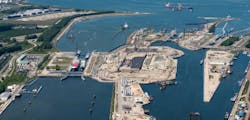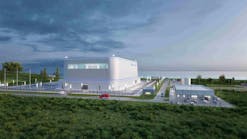Four Efficient Walls: Strategies for Commercial Buildings to reduce Energy Costs
Rising energy costs are ongoing concerns for professionals who manage commercial buildings.
Fortunately, proactive behaviors and thoughtful plans can help people find meaningful solutions that keep expenses manageable and result in other impressive benefits. Here are some practical strategies to consider.
Perform an Energy Audit
Saving energy in a commercial building can seem like a daunting task, and it often becomes one if people don’t adhere to a targeted and results-driven approach. Conducting an energy audit is one of the best starting points. It creates a baseline while highlighting how a building already uses energy well and where people could make improvements.
The audit findings might show it’s time for a hospital to update an aging climate-control system or that a military base should use smart lights and connected sensors to automatically reduce energy usage when rooms become empty. Those revelations show people where to focus their efforts to get the best results.
Although an energy audit indicates the overall energy used, it also allows people to drill down and see specifics, such as which pieces of equipment use the most energy or if particular processes are more energy-intensive than necessary. Those details can motivate executives to authorize the resources for lasting changes.
Additionally, the energy audit results include suggestions for what clients should do to meet their stated goals and how much those actions would cost. That information aids budget planning and allows people to plan their energy efficiency actions in stages.
Reinvest Money From Saved Energy Into Long-Term Improvements
Once building managers start seeing the positive results of energy-efficiency changes, they feel more confident about continuing to make relevant investments that allow an organization to maintain its momentum. One worthwhile strategy is to use money associated with money saved through energy efficiency into things that enhance a building or organization for years to come.
Ireland’s University College Cork (UCC) took that approach by developing a scheme that focused on saving energy in the sites that used the most of it. An analysis showed only 13 of UCC’s 130 buildings used 87% of the organization’s €4 million energy budget. The campus energy manager sought to change that by implementing a revolving fund plan.
It allowed departments or schools that saved energy to reinvest that money into other upgrades that support the environment. For example, one of the libraries achieved a 7% reduction in annual energy usage after an initial determination that the facility used 8.6% of UCC’s total consumption. Representatives used the money saved to install an air barrier at the main entrance to reduce the impact of drafts. That change saved more energy while increasing occupant comfort.
Building operations comprise more than 40% of the energy used in the United States. However, UCC provides a strong example of how to reduce that figure while making further investments for the future.
Prioritize Retrofits Over New Construction When Possible
It’s often easy to justify new construction over retrofitting when working toward energy-efficiency goals. Many people think it seems easier to start from scratch rather than make adjustments to new buildings. But you’ll often find that’s not always the most practical option or a financially feasible solution.
People overseeing energy-efficiency upgrades at Virginia’s Fort Eustace and Fort Story military bases realized that and got remarkable results. The changes included 77,000 lighting-efficiency updates and the installation of 475 efficient heat pumps. The retrofitting included the deployment of nearly 1,000 smart thermostats, too.
Those involved with the process expect the improvements — which affected more than 1,000 military households — will curb consumption by an estimated 3,286,588 kilowatt-hours annually. They sought to improve quality of life for families while supporting President Joe Biden’s executive order for addressing climate change. Elsewhere, Biden recently signed a bill resulting in $370 billion of new energy tax credits, signaling that sustainability is a priority for his administration.
Explore How Advanced Technologies Could Help
People can also get significant energy savings gains in commercial buildings by using artificial intelligence (AI) or other innovative and emerging technologies. AI is particularly useful because it can learn a building’s trends, then automatically adapt to achieve the best results.
A 2020 pilot project in an Equinix data center shows what’s possible. Participating parties planned to develop an AI application to monitor, analyze and optimize energy supplies for the data center’s cooling system. The first step involved a comprehensive energy-use analysis. It showed the facility already operated efficiently, but additional optimization opportunities existed. One of the findings was that the climate-control system kept the environment cooler than needed under typical conditions.
The implemented AI system accounted for factors like weather and internal loads. It now keeps the data center’s cooling level appropriate for 99% of its annual operations. Leaders believe this change will cause a 48% reduction in the system’s energy input per year.
Another possibility is to create a digital twin of cooling systems or other aspects that use energy in a facility. The digital twin allows people to test various scenarios in a simulated environment before trying them in real life. They then can become aware of unforeseen consequences and adapt to them instead of making costly and time-consuming mistakes.
How Will You Make Energy Costs More Manageable?
These are some of the practical things people have done to make commercial buildings use less energy, and you can use them for inspiration, too. A final thing to remember is that no single strategy is a universal fix for every situation. Instead, you must review the aspects of your circumstances, then find the available solutions that seem most appropriate.
It also often takes time to see the full results of anything new. Be patient, especially if whatever you change requires workflow-related tweaks or employee education.
- - -
About the author: Emily Newton is an industrial and tech journalist who’s passionate about how technology is revolutionizing each sector. She has over five years experience writing and editing and enjoys her role as Editor-in-Chief of Revolutionized.
Read more from Emily Newton at EnergyTech.com
How to Break Down Barriers to Energy Efficiency in Health Care?
What can Universities do to earn an A+ in Renewable Energy use?






